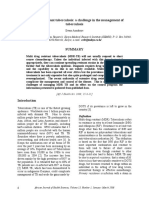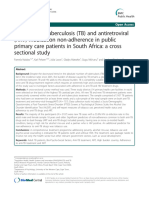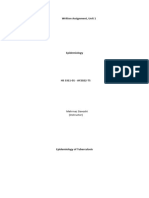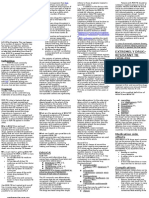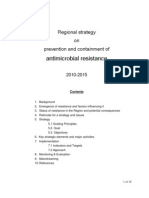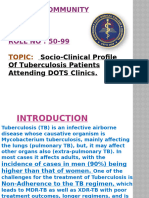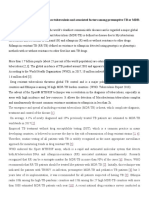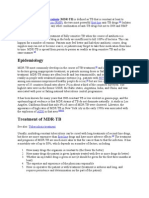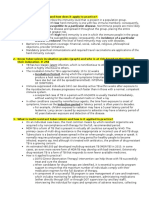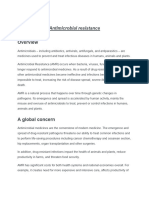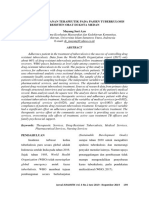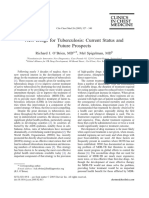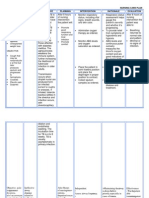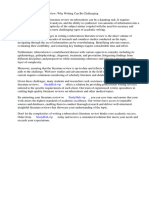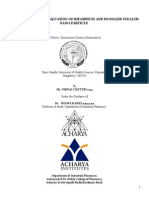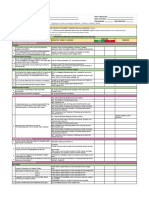JH 08003
JH 08003
Uploaded by
Nur Afni PonsengCopyright:
Available Formats
JH 08003
JH 08003
Uploaded by
Nur Afni PonsengOriginal Description:
Original Title
Copyright
Available Formats
Share this document
Did you find this document useful?
Is this content inappropriate?
Copyright:
Available Formats
JH 08003
JH 08003
Uploaded by
Nur Afni PonsengCopyright:
Available Formats
African Journal of Health Sciences, Volume 15, Number 1, January- March 2008
6
Multi drug resistant tuberculosis: a challenge in the management of
tuberculosis
Evans Amukoye
Center for Respiratory Diseases Research; Kenya Medical Research Institute (KEMRI), P. O. Box 54840-
00200 Nairobi, Kenya; e-mail: crdr@todays.co.ke
SUMMARY
Multi drug resistant tuberculosis (MDR-TB) will not usually respond to short
course chemotherapy. Unless the individual infected with this bug is treated
appropriately, they can continue spreading resistant strains in the community and
further fuel the tuberculosis epidemic. Diagnosis requires drug sensitivity testing
and the capability to do this is not widely available. Multi drug resistant
tuberculosis has been reported all over Africa but the prevalence is still low. The
treatment is not only expensive but also quite prolonged and compliance cannot be
overemphasized. The recent outbreaks of extensive drug resistant TB further
complicate the management and control of the disease. This is a perspective on
challenges of managing MDR TB and its effect on the control program the
information presented is gathered from published data.
[Afr J Health Sci. 2008; 15:6-13]
Introduction
Tuberculosis (TB) is one of the fastest growing
epidemics. Worldwide over 1 billion people are
infected with dormant TB. Nine to eleven
million people have active TB predominately in
Asia, Africa, and Latin America, and almost 3
million people die of TB annually, including
half a million children. WHO estimates that 4.5
million people are co-infected with the human
immunodeficiency virus (HIV) and TB. TB
flourishes where there is poverty, malnutrition,
overcrowding, and deficient health care [1]. In
Kenya the notification rate of all forms of TB
over the past 5 years has been increasing by an
average of 14%. Reported cases of Tuberculosis
have risen from 10,000 in the 1980s to over
100,000 in 2004 [2]. The increase has been
driven mainly by the high prevalence of HIV in
the population. It is estimated that up to 60% of
TB patients are co-infected with HIV in Kenya
[2]. MDR TB, which has been demonstrated to
occur in indigenous Kenyans, could complicate
management of TB and erode the gains made by
DOTS if its prevalence is left to grow in the
country [3].
Definition
Multi-drug resistant (MDR) Tuberculosis refers
to resistance in vitro to at least Isoniazide (INH)
and rifampicin (RIF). Resistance to at least two
drugs other than the combination of INH and
RIF is known as polyresistant tuberculosis and
monoresistance is the resistance due to only one
anti-tuberculosis medication [4]. This definition
is based on the fact that INH plus RIF is the
most important combination and resistant to
them will lead to failure of short course
chemotherapy even though resistant to other
drugs could also lead to failure. MDR TB may
be due to acquired resistance, that is strain of M.
tuberculosis that was initially sensitive to DOTS
drugs, but becomes resistant to drugs within an
individual in the setting of low drug levels,
intermittent therapy or effective monotherapy.
Primary resistance is infection with a strain in
African Journal of Health Sciences, Volume 15, Number 1, January- March 2008
7
M. tuberculosis that is already resistant to
important first-line drugs [4].
Cases of MDR TB have been documented
throughout the world including in the United
States, South America, Central America, Africa,
Mexico, Russia and the former Soviet Union,
Western Europe, Eastern Europe, the Caribbean,
Asia, New Zealand and Austria. The problem
has been growing over the past several years and
mathematical modeling suggests that unless a
concerted effort is made to stop MDR TB, it will
become a major public health problem on
several continents [3-14].
Causes
Effective therapy for disease due to M.
tuberculosis was discovered in l943, when
streptomycin (SM) was identified. It was noticed
that patients with TB who initially improved on
SM often failed therapy; they no longer then
responded to the drug, even at higher doses.
Although a single potent drug could often
eradicate the majority of tubercle bacilli, natural
mutants resistant to that drug survived to
become the dominant strain [15]. This mutant
was then transmitted to other members of the
community. INH and paramino salicylic acid
(PAS) were developed shortly after SM, but
when used alone, they would also develop
acquired resistance [16,17]. It was then
recognized that combinations of antituberculous
drugs could prevent the development of drug
resistance and thus, treatment regimens
including more than one antituberculous drug
became the standard of care.
It is worth reiterating that MDR TB, a
relatively new threat to health, is an entirely
man-made phenomenon; antituberculous drug
resistance is the result, ultimately, of poor
therapeutic practices [18]. If TB-control efforts
had been well organized decades ago, it is likely
that the dimensions of this problem would be
significantly smaller. Thus, the introduction of
systematic and effective control of drug-
sensitive TB, through DOTS, is our best weapon
against the generation of drug resistance [19].
Directly Observed Therapy, Short Course
(DOTS) refers to a specific type of tuberculosis-
control program, requiring the following
elements: 1) government commitment to a
National Tuberculosis Program; 2) passive case-
finding in general health services by sputum
smear microscopy examination of samples from
suspected TB cases; 3) standardized short-course
chemotherapy administered to at least all smear-
positive TB cases under specified case-
management conditions with therapy being
directly observed; 4) regular uninterrupted
supply of all essential antituberculous drugs; and
5) a monitoring system for program supervision
and evaluation. A strategy to manage MDR TB
that takes advantage of the many strengths of the
DOTS strategy is known as DOTS-Plus
[19,20].
Failure of DOTS to adequately treat drug-
resistant TB (whether polyresistant or MDR TB)
lead to generation of further resistance and
ultimately the circulation of highly resistant
strains of M. tuberculosis. The result of the
generation of high-grade drug resistance by
inadequate therapy is not only grave for the
patient, but for the community at large, as drug-
resistant strains are spread by the same airborne,
person-to-person mechanism as a susceptible
strains of TB Drugs. DOTS is ineffective for
curing either form of MDR TB and for
preventing further spread of drug-resistant
strains in the community. It is worth to note that
not all re-treatment cases of tuberculosis have
MDR. In Malawi of 164 culture positive, 81%
(122) were fully sensitive and only 4% (6) had
MDR [21]
Factors that favor the development and spread of
MDR-TB are incomplete or inadequate therapy
that can select for drug-resistant mutants of M
tuberculosis. Prolonged infectiousness of
patients due to delayed diagnosis of MDR TB
and to the absence of effective therapy also
allows ongoing transmission of drug-resistant
strains to susceptible contacts. Patients with
cavitary lesion have a tendency to have a more
chronic illness and higher chance of having
MDR and should be isolated especially from
immuno-compromised HIV patients [7].
Patients infected with primary drug-
resistant TB treated with short-course
chemotherapy are less likely to be cured.
Patients sick with drug-resistant TB exposed to
short-course chemotherapy can further acquire
resistance through inadvertent monotherapy
(the amplifier effect) [22]
African Journal of Health Sciences, Volume 15, Number 1, January- March 2008
8
Kenyan situation
Since the introduction of short course
chemotherapy in Kenya in 1993, the treatment
success rate has been about 80%, the death rate
reduced from 1% to 0.4%. In 2003 7% of all TB
treatment were on re-treatment regime [2].
Though there is usually a higher drug resistance
in the re-treatment population, it may not be
evidence of MDR and outcome of re-treatment
may be good, as shown in a study done in
Malawi [21].
A well run control program such is
available in Kenya is important in reducing
secondary (acquired) drug resistance. In 1995
MDR was not reported in general population but
was isolated among the refugees. [3] This is no
longer so as patient seeking culture services at
the Kenya Medical Research Institute (KEMRI),
11.4% of the 983 specimen tested positive for
MDR tuberculosis [23,24]. This was the first
time MDR was documented in indigenous
Kenyans, even though there have been sporadic
reports of MDR from public and private sector.
KEMRI has undertaken a survey of drug
resistant Tuberculosis and the results will soon
be published. In Ethiopia, our neighbour, Multi-
drug-resistance (MDR) TB was reported to be
about 1.2% of new cases and 12% of re-
treatment cases [25].
Situation in children
It is difficult to diagnose MDR tuberculosis in
children and this results in delay in treatment. In
South Africa the median age of diagnosing
tuberculosis was 4.5 years at first TB diagnosis
and 6.2 years on MDR culture confirmation.
Delay in starting appropriate MDR treatment
after TB diagnosis was a median of 2 days if
MDR TB source cases were taken into account,
but 246 days if the drug susceptibility pattern of
the source case was not considered, and 283
days if there was no known tuberculosis source
case. Seventeen children had smear positive
tuberculosis, of which 13 had cavitatory
pulmonary disease. Eight children had central
nervous system TB. Thirty-six children were
treated for MDR tuberculosis, of whom four
died. Obtaining a detailed contact history and
their culture and sensitivity result is essential in
reducing the delay in starting treatment. Delay
of starting appropriate MDR anti-tuberculosis
treatment has potentially serious consequences
[26].
DOTs-plus strategy
Evidence, and consequent estimates, suggested
that the MDR situation in developing Countries,
especially in sub-Saharan Africa, is deteriorating
rapidly [27]. Similarly, major increases in
tuberculosis have been observed in the former
USSR. It was estimated that some 7-8 million
new cases and 2-3 million deaths were occurring
annually in the world. The global targets of
reaching 85% cure rates and 70% case detection
among infectious cases were established by the
World Health Assembly in 1991. The WHO
declaration of TB as a global emergency in 1993
and the launch of the five-element DOTS
strategy in 1994-1995 resulted in countries
adopting DOTS in encouraging numbers. In
2000, 148 countries including all 22 highest
burden countries (HBC) responsible for 80% of
cases worldwide, had adopted the new DOTS
strategy [27]
WHO position statement on MDR TB is
To achieve TB control worldwide and to
prevent the emergence of anti-
tuberculous drug resistance, the WHO
considers implementation of sound TB-
control based on the DOTS strategy as a
top priority.
Recognizing that MDR TB is a
considerable threat to the effectiveness
of DOTS in some areas of the world,
WHO strongly supports pilot projects to
assess the feasibility of DOTS-Plus
interventions in a variety of settings,
provided DOTS is in place.
Based on the results of these pilot
projects, WHO and its partners in the
newly established Working Group on
DOTS-Plus for MDR TB will formulate
international policy recommendations
on MDR TB management. [19]
Effects of HIV on MDR TB
History of previous TB treatment, and not HIV
infection, was the principal factor associated
with TB, which is resistant to at least one
primary anti-TB Drug. HIV co-infection can
African Journal of Health Sciences, Volume 15, Number 1, January- March 2008
9
shorten the period from TB infection to disease
leading to lengthier periods of infectiousness. In
a population-based representative data on new
and previously treated patients with TB
collected within an international drug resistance
surveillance network, Espinal et al concluded
that prior but ineffective treatment is a strong
predictor of drug resistance, and that HIV is not
an independent risk factor for MDR-TB [28].
The association between length of
treatment and drug resistance may reflect longer
treatment as a result of treatment failure in
patients with drug resistance; it may also reflect
irregular prior treatment for TB, leading to drug
resistance. However, as the HIV epidemic
progresses in a milieu of high TB prevalence,
the link with drug-resistant TB warrants constant
monitoring and investigation [28].
Treatment of MDR TB
Management of MDR-TB relies on prompt
recognition. Traditional culture of
Mycobacterium tuberculosis isolates on solid
media is slow, a commercialized molecular
genetic test for a limited number of target loci
might be a good alternative for a drug
resistance-screening test in the context of an
MDR DOTS-plus strategy [29].
DOT-plus strategy is more crucial in the
treatment of MDR TB because of the extended
duration and the potential for greater side effect.
Emerging data suggest that in younger patients
with little co-morbidity, the occurrence of
serious adverse effect is rare and does not
compromise treatment outcome. Trained
individuals with experience in second line drugs
are preferred to supervise therapy, but
administration of medication in health centers
could promote transmission of nosocomial MDR
TB. A number of studies have demonstrated the
effectiveness of community health workers in
responding to serious challenges to health. The
value of directly observed therapy in the
treatment of MDR TB can not be
underestimated, this could include mouth check
after swallowing drugs, serum check where this
is available and/or examining for side effect
such as bronzing of the skin with clofazimine to
ensure adherence.
The foundation of treatment consists four
to five drugs to which the infecting bug is
(likely) susceptible. The regime should include a
parenteral drug, a first line drug to which the
infective strain is likely susceptible and a
fluoroquinolone whenever possible. Choose
bactericidal (more efficacious) to which the
patient has no allergy. Tuberculosis is
sometimes partially resistant to Isoniazide, in
such situations it can be used at a higher dose in
conjunction with pyridoxine. Isoniazide cant be
used in higher doses in conjunction with
pyridoxine in situations where TB is fully
resistant to it. Adjuvant treatments that can be
used include the use of cortcosteroids in patients
with severe respiratory distress, central nervous
system involvement or laryngeal TB to try and
prevent permanent sequelae of chronic
inflammation. Surgery has been recommended
with good results in patients with unilateral or
focal disease that has no clinical response after 3
to 6 months of specific therapy. Other
indications of surgery are high-grade resistance
with extensive parenchymal damage, recurrence
of positive smear or culture during or after
treatment. [30].
Adverse drug reactions
The adverse drug reactions depend on drugs
used. The following are some of the documented
adverse reaction: Nervous system- includes
headache, weakness, fatigue somnolence and
insomnia. More serious reaction includes
seizure, peripheral neuropathy, ototoxicity, optic
neuritis and psychiatric reaction. Gastrointestinal
side effects -are nausea, vomiting, diarrhea,
bloating, abdominal cramps and gastritis. Rarely
gastric ulcer or hepatitis may occur.
Endocrine effect such as worsening of
glycemic control in diabetics, changes in
menstrual period and hypothyroidism may
occur.
Dermatological reactions such a skin color
changes, photosensitive, and dry skin are
frequently observed, while anaphylaxis and
Stevens-Johnson syndrome are rare but
potentially lethal. Renal and electrolyte
disturbances include acute renal insufficiency,
nephrolithiasis, proteinuria hypokalemia and
hypomagnesemia.
Other minor adverse effects include
arthralgias, myalgias, cramps and candidal
vaginitis. Dehydration and/or weight loss,
African Journal of Health Sciences, Volume 15, Number 1, January- March 2008
10
associated with gastrointestinal symptoms, may
occur in the early months of treatment. [31-38].
Duration of treatment
Treatment of MDR TB is long, it is
recommended that parenteral medication should
continue for six months and oral medicine
should continue until there is 18 to 24 months of
culture negative sputum (specimen). Clinical
response, radiological response and degree of
resistance also determine the duration of
treatment. After terminating treatment routine
follow up and specimen collected for culture
every 6 months for 24 months [39]. The
prognosis of patients treated for MDR TB has
been improving as effective drugs become
available and as experience is gained in treating
this condition. In a study done in South Africa
out of 443 patients infected with MDR TB after
5 years 44% had died, 15% had severe chronic
respiratory disease, and only 33% we cured. The
situation has improved with almost an 80% cure
in some setting where DOTs- plus is practiced
[40].
Extensive drug resistance (XDR)
Physician working in Kwazula Natal, South
Africa in 2005 noticed rapid deaths among
patients with co-infection of TB and HIV [41].
Gadhi et al compiled 1539 patients with
tuberculosis from this area. MDR was detected
in 221 of these patients of whom 53 had XDR.
All of those tested for HIV (44) were HIV
positive. 52 of 53 patients died with median
survival of 16 days from the time of diagnosis.
85% of the isolates had similar strain. 55% of
these patients had not previously been treated
[42].
XDR tuberculosis is defined as MDR
(Resistant Rifampicin and Isoniazid) as well as
resistant to at least two of the 6 primary classes
of second line drugs, one being a
fluoroquonolone and the other an injectable drug
[43]. Centers for Disease Control (CDC) and
WHO in 2006 documented XDR in at least 17
countries. The data showed 10% of MDR were
XDR. Data from USA, Latin and Kofa showed
that the XDR rates range from 4% to 19%
among MDR isolates [41].
Since a percentage of MDR is XDR it
means that XDR must be existing in Kenya
though the number may be small as MDR is not
yet a major problem in this country. The cause
of MDR and XDR is due to inappropriate use of
first line and second line drugs and the failure to
diagnosis patients leads to increased spread of
the strains diseases. Therefore it is necessary to
strengthen the laboratory capacity and improve
adherence to taking tuberculosis drugs or
otherwise face a situation in which the spread of
TB will be driven by both HIV scourge and
MDR/XDR. Research into new drug sneed to be
speeded up.
Conclusion
The prevalence of MDR Tuberculosis is still low
in Africa compared to Eastern Europe, but it is
growing and should be addressed in time. Even
though the price of treatment was brought down
in countries such as Peru. The cost of treating
MDR TB in Kenya is estimated to be 1.3 million
Kenya Shilling (personal communication by
NLTP manager) which is out of the reach of
most of its citizen. While HIV is fueling the TB
epidemic in sub- Sahara, MDR does the same in
Eastern Europe. We are facing a situation in
which we will have MDR, HIV mixed in a
milieu of poverty, a situation we dare not
imagine.
Kenya should endeavor to reduce the
emergence and spread of MDR-TB by
emphasizing on strict adherence to DOTs
strategy. TB drugs should be administered in
DOTs registered centers. Any patient with
evidence of long standing disease such as
demonstration of cavities on chest X-ray, should
be isolated until drug sensitivity result is known,
as MDR-TB is common in long standing
disease. All patients with MDR-TB should be
treated promptly therefore the effort the National
Leprosy and Tuberculosis Program to introduce
DOTS-plus is highly supported. The
introduction of DOTS-plus could also
remarkably reduce the cost of treating MDR-TB.
The management of XDR will remain a
challenge as there is a no effective treatment and
isolation for indefinite period could raise human
right issues. Health workers working with
patients infected with MDR/XDR or even
suspect TB should have HIV tests regularly.
Those found positive should opt to work in less
African Journal of Health Sciences, Volume 15, Number 1, January- March 2008
11
risky environments. I conclude by stating that
MDR/XDR tuberculosis is a growing threat in
the control of tuberculosis and this is the time to
act.
Acknowledgement
I acknowledge with thanks tremendous support
and permission from the Director, KEMRI that
has made this write-up possible.
References
1.
McKenna N.A dangerous liaison:
tuberculosis and HIV. World AIDS.
1992 Sep;(23): 3 p.
2.
Ministry of Health, Kenya. National
Leprosy and Tuberculosis Program
(NLTP). Annual report. 2003.
3. Githui WA, Juma ES, van Gorkom J,
Kibuga D, Odhiambo J and
Drobniewski F. Anti-tuberculosis drug
resistance surveillance in Kenya
International Journal of Tuberculosis
and Lung Disease. 1998; 2: 499-505.
4.
Partners in Health.- Harvard Medical
School, Bill & Belinda Gates
Foundation. A DOTS-Plus Hand Book,
Guide to Community based treatment of
MDR TB.
5.
Breathnach AS, de Ruiter A,
Holdsworth GMC, Bateman NT,
OSullivan DG, Rees PJ, Snashall D,
Milburn HJ, Peters BS, Watson J,
Drobniewski FA, French GL. An
outbreak of multi-drug-resistant
tuberculosis in a London teaching
hospital. Journal of Hospital Infection.
1998; 39: 111-117.
6.
Agerton T, Valway S, Gore B, pozsik C,
Plikaytis B, Woodley C, Onorato I.
Transmission of a highly drug-resistant
strain (strain W1) of Mycobacterium
tuberculosis: community outbreak and
nosocomial transmission via a
contaminated bronchoscope. Journal of
the American Medical Association.
1997; 278: 1073-1077.
7.
Aita J, Barrera L, Reniero A, Lopez B,
Biglione J, Weisburd G, Rajmil JC,
largacha C, Ritacco V . Hospital
transmission of multi-drug-resistant
Mycobacterium tuberculosis in Rosario,
Argentina. Medicina (B. Aires) 1996:56:
48-50.
8.
Chacon L, Cruz JR, Tardenchilla A.
Primary resistance and MDR TB in
Nicaragua. International Journal of
Tuberculosis and Lung Disease. 1999; 2
(11 suppl.2): S332.
9.
Grandes G. Lopez-de-Munain J, Diaz T,
Rullan JV. Drug-resistant tuberculosis in
Puerto Rico. 1987-1990. American
Review of Respiratory Diseases. 1993;
148: 6-9
10.
Raviglione MC, Rieder HL, Styblo K,
Khomenko AG, Esteves K, Kochi A.
Tuberculosis trends in eastern Europe
and the former USSR. Tubercle and
Lung Disease. 1994; 75: 400-16.
11.
Stepanshina VN, Panfertsev EA,
Korobova OV, Shemyakin IG,
Stepanshin YG, Medvedeva IM,
Dorozhkova IR. Drugresistant strains
of Mycobacterium tuberculosis isolated
in Russia. International Journal of
Tuberculosis and Lung Disease. 1999;
3:149-152.
12.
Dawson DJ, Cheat DF, Chew WK,
Haverkort FC, Lumb R, Slevers, AS.
Tuberculosis in Australia, 1989-1992:
bacteriologically confirmed cases and
drug resistance. Medical Journal of
Australia. 1995; 162: 287-290.
13.
Ou Z, Xi-fu W, Jie Y. Initial drug
resistance to anti-tuberculosis drugs
among inpatients of a provincial chest
hospital in China 1980-1991. Tubercle
and Lung Disease. 1996. 77 (Suppl. 2):
62.
14.
Dye C, Espinal MA.Will Tuberculosis
become resistant to all antibiotics.
Proceedings: Biological Sciences The
Royal Society . 2001; 268: 45-52.
15.
Crofton J, Mitchison D. Streptomyclin
resistance in pulmonary tuberculosis.
British Medical Journal. 1948:2:1009-
1015.
African Journal of Health Sciences, Volume 15, Number 1, January- March 2008
12
16.
Barry VC, Conalty MI, Gaffney E.
Isoniazid-resistant strains of
Mycobacterium tuberculosis. Lancet
1953; 1:978-9.
17.
Devadatta S, Dawson JJY, Fox W,
Janardhanam B, Radhakrishna S,
Ramakrishnan CV, Velu S. Attack rate
of tuberculosis in a 5 year period among
close family contacts of tuberculous
patients under domiciliary treatment
with isoniazid plus PAS or isoniazid
alone. Bulletin of the World Health
Organization. 1970; 42:337-351
.
18.
Iseman MD, Tailoring a time bomb.
Inadvertent genetic engineering.
American Review of Respiratory
Diseases. 1985; 132: 735-736.
19.
World Health Organization
Coordination of DOTS-Plus pilot
projects for the management of MDR-
TB. Geneva. World Health
Organization.
WHO/CDS/CPC/TB/99.262. 1999
20.
World Health Organization. What is
DOTS? A guide to understanding the
WHO recommended TB control strategy
known as DOTS. Geneva: World Health
Organization,
WHO/CDS/CPC/TB/99.27. 1999.
21. Salaniponi FM, Nyirenda TE, Kemp JR,
Squire SB, Godfrey-Faussett P, Harries
AD. Characteristics, management and
outcome of patients with recurrent
tuberculosis. Under routine programme
conditions in Malawi. International
Journal of Tuberculosis and Lung
Disease. 2003; 7:948-952.
22. Farmer P, Bayona J, Becerra M, Furin J,
Henry C, Hiatt H, Kim JY, Mitnick C,
Nardell E.The dilemma of MDR- TB in
the global era. International Journal of
Tuberculosis and Lung Disease. 1998;
2: 869-876
23. Githui WA, Meme HK, Juma ES,
Kinyanjui P, Karimi F, Chakaya JM,
Kangangi J, Kutwa A.Isolation of
Multidrug-resistance tuberculosis strains
in patients from private and public
health facilities in Nairobi, Kenya.
International Journal of Tuberculosis
and Lung Disease. 2004; 8: 837-841
24. Githui WA, Hawken MP, Juma ES,
Goefrey-faussett P, Swai OB, J, Kibuga
DK, Porter JD, Wilson SM,
Drobniewski FA.Surveillance of drug-
resistance tuberculosis and molecular
evaluation of transmission of resistant
strains in refugee and non refugee
population in north- eastern Kenya.
International Journal of Tuberculosis
and Lung Disease. 2000; 4:947-955
25. Abate G. Drug-resistant tuberculosis in
Ethiopia: problem scenarios and
recommendation. Ethiopian Medical
Journal. 2002; 40:79-86.
26. Schaaf HS, Shean K, Donald PR.
Culture confirmed multi-drug resistant
tuberculosis: diagnostic delay, clinical
features, and outcome. Archives of
Disease in Childhood. 2003; 88:1106-
1111
27. World Health Organisation.
Tuberculosis Strategy & Operations,
Stop TB Department, World Health
Organization.
28. Espinal MA, Laserson K, Camacho M,
Fusheng Z, Kim SJ, Tlali RE, Smith I,
Suarez P, Antunes ML, George AG,
Martin-Casabona N, Simelane P, Weyer
K, Binkin N and Raviglione MC. World
Health Organization, communicable
diseases, Geneva, Switzerland.
29. Nachega JB, Chaisson RE. Tuberculosis
drug resistance: a global threat. Clinical
Infectious Diseases. 2003; 36 (Suppl
1):S24-30.
30. Iseman MD. A clinicians guide to
tuberculosis Lippincott Williams and
Wilkins, Philadelphia, 2000. 460p
31. Ormerod LP, Horsfield N. Frequency
and type of reactions to antituberculosis
drugs: observations in routine treatment.
Tubercle and Lung Disease. 1996;
77:37-42.
32. Holdiness MR. Clinical
pharmacolokinetics of the
antituberculosis drugs. Clinical
Pharmacokinetics. 1984; 9:511-544.
33. Zierski M, Bek E. Side effects of drug
regimens used in short course
chemotherapy for pulmonary
African Journal of Health Sciences, Volume 15, Number 1, January- March 2008
13
tuberculosis. A controlled clinical study.
Tubercle 1980; 61:41-49.
34. Tack KJ, Smith JA. The safety profile of
ofloxacin. American Journal of
Medicine. 1989; 87:78S-81S.
35. Holdiness MR. Neurological
manifestations and toxicities of the anti-
tuberculosis drugs. A review. Medical
Toxicology. 1987; 2: 33-51.
36. Akhtar AJ, Crompton GK, Schonell
ME. Para-aminosalicylic acid as a cause
of intestinal malabsorption. Tubercle.
1968; 49:328-331.
37. Bucco T. Meligrana G, De Luca V.
Neurotoxic effects of cycloserine
therapy in pulmonary tuberculosis of
adolescents and young adults.
Scandinavian Journal of Respiratory
Diseases. 1970; 71: 259-265.
38. Moore VJ. A review of side effects
experienced by patients taking
dofazimine. Leprosy Review. 1983;
54:327-335.
39. Fraser HF, Jazayeri D, Kempton K,
Mosely M, Choi S, Pachao F, Bayona J.
A system for modeling medication
requirements for the management of
drug resistant tuberculosis in developing
countries. Medinfo. 2004; 2004
(CD):1603
40. Schaaf HS, Botha P, Beyers N, Gie RP,
Vermeulen HA, Groenewald P, Coetzee
GJ and Donald PR. The 5-year outcome
of multidrug resistant tuberculosis
patients in the Cape Province of South
Africa. Tropical Medicine and
International Health. 1996 1:718-722.
41. Mario C. Raviglione MD and Smith IM,
MB CHB. XDR Tuberculosis-
implications for global public health.
The New England Journal of Medicine.
2007; 356: 656-659.
42. Gandhi NR, Moll A, Sturm AW,
Pawinski R, Govender T, Lalloo U,
Zeller K, Andrews J and Friedland G.
Extensively drug-resistant tuberculosis
as a cause of death in patients co-
infected with tuberculosis and HIV in a
rural area of South Africa. Lancet.
2006; 368:1575-1580.
43. Gandhi NR, Moll A and Sturm AW.
Extensively drug-resistant tuberculosis
(XDR-TB): recommendations for
prevention and control. Weekly
Epidemiological Record. 2006; 81: 431-
432.
You might also like
- MOH 515 Updated 2022Document1 pageMOH 515 Updated 2022MARTIN100% (5)
- How To Take Sputum Suitable For TB - InspectionDocument1 pageHow To Take Sputum Suitable For TB - InspectionGeneXpert Lab LCPNo ratings yet
- jh08003 PDFDocument8 pagesjh08003 PDFkiranaNo ratings yet
- Multidrug-Resistant Tuberculosis (MDR-TB) Is Defined As TB That Is Resistant To BothDocument4 pagesMultidrug-Resistant Tuberculosis (MDR-TB) Is Defined As TB That Is Resistant To Bothsanny_sundariNo ratings yet
- WHO Bulletin 2005Document10 pagesWHO Bulletin 2005ajh2675No ratings yet
- What Is Multidrug-Resistant Tuberculosis (MDR-TB) and How Do We Control It?Document2 pagesWhat Is Multidrug-Resistant Tuberculosis (MDR-TB) and How Do We Control It?Dvica SarahNo ratings yet
- Factor Associated With TBCDocument8 pagesFactor Associated With TBCaura tmc 10No ratings yet
- Singh., 2020. Mekanisme Resistensi ObatDocument21 pagesSingh., 2020. Mekanisme Resistensi Obathasan andrianNo ratings yet
- Linezolid To Treat MDR-/XDR-tuberculosis: Available Evidence and Future ScenariosDocument5 pagesLinezolid To Treat MDR-/XDR-tuberculosis: Available Evidence and Future ScenariosNop PiromNo ratings yet
- MDR TB FactsheetDocument2 pagesMDR TB FactsheetfaradillaNo ratings yet
- Predictors of Tuberculosis (TBDocument11 pagesPredictors of Tuberculosis (TBchikomuezza19No ratings yet
- Paper TB MDRDocument8 pagesPaper TB MDREra SulistiyaNo ratings yet
- Written Assignment 1Document5 pagesWritten Assignment 1zedotelNo ratings yet
- 1 s2.0 S1198743X16303639 Main PDFDocument7 pages1 s2.0 S1198743X16303639 Main PDFMuhammad Addinul HudaNo ratings yet
- Burden of Tuberculosis - Combating Drug Resistance: EditorialDocument3 pagesBurden of Tuberculosis - Combating Drug Resistance: EditorialmominamalikNo ratings yet
- BY Dr. Tahmina AzharDocument71 pagesBY Dr. Tahmina Azharscribdnotes123No ratings yet
- TBC and VihDocument12 pagesTBC and VihCynthia O. CórdovaNo ratings yet
- WHO Antimicrobial ResistanceDocument4 pagesWHO Antimicrobial ResistanceDesalegnNo ratings yet
- Long Walk TBDocument3 pagesLong Walk TBdellanurainiNo ratings yet
- Surveillance Evaluation Report of Tuberculosis in District Bhawalpur-2018 by DR Ammara TahirDocument22 pagesSurveillance Evaluation Report of Tuberculosis in District Bhawalpur-2018 by DR Ammara TahirSantosh WadhwaniNo ratings yet
- Zhang 2015Document15 pagesZhang 2015Annisa Nurfiatul AiniNo ratings yet
- Mayoclinproc 86 4 014 PDFDocument14 pagesMayoclinproc 86 4 014 PDFAnisoara AvonNo ratings yet
- MultidrugDocument3 pagesMultidrugMelisa MalikNo ratings yet
- Multi-Drug-Resistant Tuberculosis (MDR-TB) Is Defined: EpidemiologyDocument3 pagesMulti-Drug-Resistant Tuberculosis (MDR-TB) Is Defined: EpidemiologyJhemar Handa JulhamidNo ratings yet
- Epidemiology of Tuberculosis - UpToDateDocument33 pagesEpidemiology of Tuberculosis - UpToDateCentro de salud El quincheNo ratings yet
- Ginsberg and Spigelman Nat Med 2007Document5 pagesGinsberg and Spigelman Nat Med 2007hst939No ratings yet
- Scientific BriefDocument3 pagesScientific BriefRose Virginie Coo GowaNo ratings yet
- Drug Resistance of TBDocument17 pagesDrug Resistance of TBGaurav Sharma100% (1)
- Antimicrobial Resistance: Regional Strategy On Prevention and Containment ofDocument20 pagesAntimicrobial Resistance: Regional Strategy On Prevention and Containment ofAjit SolankiNo ratings yet
- Multidrug-Resistant Tuberculosis in Uzbekistan: Results of A Nationwide Survey, 2010 To 2011Document12 pagesMultidrug-Resistant Tuberculosis in Uzbekistan: Results of A Nationwide Survey, 2010 To 2011IsoqjonivichNo ratings yet
- Survival Status and Treatment Outcome ofDocument6 pagesSurvival Status and Treatment Outcome ofEghar EverydayishellNo ratings yet
- TB Project (02) 07 finaleDocument60 pagesTB Project (02) 07 finaleSamim AhmedNo ratings yet
- TB (2) - 1Document62 pagesTB (2) - 1Samim AhmedNo ratings yet
- Multi Drug ResistenDocument2 pagesMulti Drug ResistenNurul W.ANo ratings yet
- Mycobacteriumtuberculosis and Antibiotic ResistanceDocument19 pagesMycobacteriumtuberculosis and Antibiotic ResistanceinnocentNo ratings yet
- Mutidrug Resistant TuberculosisDocument2 pagesMutidrug Resistant Tuberculosistummalapalli venkateswara raoNo ratings yet
- Multi Drug Resistance in ChildrenDocument11 pagesMulti Drug Resistance in ChildrenMuneeb AltafNo ratings yet
- Multi-Drug-resistant Tuberculosis - Wikipedia, The Free EncyclopediaDocument8 pagesMulti-Drug-resistant Tuberculosis - Wikipedia, The Free Encyclopedianayan555No ratings yet
- DR José Caminero of The Union On Challenge of anti-TB Resistance in Context of SDGsDocument29 pagesDR José Caminero of The Union On Challenge of anti-TB Resistance in Context of SDGsbobbyramakantNo ratings yet
- Tuberculosis and Diabetes Mellitus Relating Immune Impact of Co-Morbidity With Challenges in Disease Management in High Burden CountriesDocument6 pagesTuberculosis and Diabetes Mellitus Relating Immune Impact of Co-Morbidity With Challenges in Disease Management in High Burden Countriesyoelpurnama1991No ratings yet
- Vol 42 No 13-EnglishDocument4 pagesVol 42 No 13-EnglishVijayakanth VijayakumarNo ratings yet
- Tratamiento de Tuberculosis LatenteDocument13 pagesTratamiento de Tuberculosis LatenteCarmen MolinaNo ratings yet
- Prevalence of Rifampicin Resistance Tuberculosis and Associated Factors Among Presumptive TB or MDRDocument3 pagesPrevalence of Rifampicin Resistance Tuberculosis and Associated Factors Among Presumptive TB or MDRTigray OutlookNo ratings yet
- First-Line Anti-Tuberculosis Drug Resistance Pattern: Original ArticleDocument6 pagesFirst-Line Anti-Tuberculosis Drug Resistance Pattern: Original ArticleyasserNo ratings yet
- TB Dan DMDocument6 pagesTB Dan DMrieswantisunningNo ratings yet
- New Developments in Tuberculosis Diagnosis and TreatmentDocument15 pagesNew Developments in Tuberculosis Diagnosis and TreatmentannewidiatmoNo ratings yet
- 1201 Sanchez Padilla High Prevalence of Multidrug Resistant Tuberculosis Swaziland 2009 2010 Emerging Infectious Diseases 18 1Document9 pages1201 Sanchez Padilla High Prevalence of Multidrug Resistant Tuberculosis Swaziland 2009 2010 Emerging Infectious Diseases 18 1dewi ayu wulandariNo ratings yet
- Epidemiology: Isoniazid (INH) Rifampicin (RMP) First-LineDocument14 pagesEpidemiology: Isoniazid (INH) Rifampicin (RMP) First-LineEttedab Abrogar ChavezNo ratings yet
- Disease Is Reduced. The Level of Herd Immunity May Vary With DiseasesDocument2 pagesDisease Is Reduced. The Level of Herd Immunity May Vary With DiseasesPattyNo ratings yet
- TheUnion DR TB GuideDocument2 pagesTheUnion DR TB GuideDhani KurniawanNo ratings yet
- Antimicrobial ResistanceDocument9 pagesAntimicrobial Resistancekzqwrpp484No ratings yet
- Analisis Pelayanan Terapeutik Pada Pasien Tuberkulosis Resisten Obat Di Kota MedanDocument14 pagesAnalisis Pelayanan Terapeutik Pada Pasien Tuberkulosis Resisten Obat Di Kota MedanwahyuNo ratings yet
- New Drugs For Tuberculosis PDFDocument14 pagesNew Drugs For Tuberculosis PDFRichard WooliteNo ratings yet
- Advances in Tuberculosis: Therapeutics: (August 2019) 86 (8) :700 - 702Document3 pagesAdvances in Tuberculosis: Therapeutics: (August 2019) 86 (8) :700 - 702Harpreet SinghNo ratings yet
- Prevention and Containment of Antimicrobial Resistance: Sixty-Third Session Bangkok, Thailand 7-10 September 2010Document17 pagesPrevention and Containment of Antimicrobial Resistance: Sixty-Third Session Bangkok, Thailand 7-10 September 2010gabriela_mariangela5929No ratings yet
- Nontuberculous Mycobacterial Diseases Among People Living With Hiv Plhiv at The Philippine General HospitalDocument16 pagesNontuberculous Mycobacterial Diseases Among People Living With Hiv Plhiv at The Philippine General HospitalScivision PublishersNo ratings yet
- chap 2Document13 pageschap 2burrosgaryNo ratings yet
- The WHO Strategy For TB Control and EliminationDocument12 pagesThe WHO Strategy For TB Control and EliminationAdel HamadaNo ratings yet
- Reviews: Etiology and Management of Genitourinary TuberculosisDocument11 pagesReviews: Etiology and Management of Genitourinary TuberculosisAnderson SousaNo ratings yet
- Management of HIV-associated Tuberculosis in Resource-Limited Settings: A State-Of-The-Art ReviewDocument16 pagesManagement of HIV-associated Tuberculosis in Resource-Limited Settings: A State-Of-The-Art Reviewbarokahgroup groupNo ratings yet
- NCP TBDocument6 pagesNCP TBGrhace Aquino100% (3)
- TB Teaching PlanDocument5 pagesTB Teaching PlanTrisha Fae Loyola Balagot100% (1)
- In Partial Fulfillment of The Requirements in NCM 219 - RLE Nursing Leadership & ManagementDocument48 pagesIn Partial Fulfillment of The Requirements in NCM 219 - RLE Nursing Leadership & ManagementKarl Angelo MontanoNo ratings yet
- TB Treatment in Patients With Liver DisordersDocument2 pagesTB Treatment in Patients With Liver Disordersmoipone makakoleNo ratings yet
- Fall 2011 EMT LecturesDocument1,123 pagesFall 2011 EMT Lecturesrinwho2333No ratings yet
- MDR TB Made EasyDocument58 pagesMDR TB Made EasyNezly IderusNo ratings yet
- Oman ExamsDocument68 pagesOman ExamssafasayedNo ratings yet
- TB Skin Diseases QuizDocument3 pagesTB Skin Diseases QuizCherlane KasekNo ratings yet
- Top 10 Health Agendas of The PhilippinesDocument5 pagesTop 10 Health Agendas of The PhilippinesAnne LauretaNo ratings yet
- CVS Nac-Osce BlocksDocument35 pagesCVS Nac-Osce BlocksRoop SinghNo ratings yet
- Journal of Ethnopharmacology: Lydia Bunalema, Samuel Obakiro, John R.S. Tabuti, Paul WaakoDocument6 pagesJournal of Ethnopharmacology: Lydia Bunalema, Samuel Obakiro, John R.S. Tabuti, Paul WaakoLilis Sapta Eka Lestari100% (1)
- Chapter 1. Health and Hygiene - SADocument8 pagesChapter 1. Health and Hygiene - SAPalakNo ratings yet
- 500 Most Important English Questions For CDS Exam Part 2Document259 pages500 Most Important English Questions For CDS Exam Part 2Jatin BhagatNo ratings yet
- Tuberculosis Literature ReviewDocument4 pagesTuberculosis Literature Reviewc5nazs86100% (1)
- Diseases That Needs Isolation PrecautionsDocument1 pageDiseases That Needs Isolation Precautionsjerimiah_manzonNo ratings yet
- TuberculosisDocument28 pagesTuberculosisbuddysmbdNo ratings yet
- Formulation and Evaluation of Rifampicin and Isoniazid Stealth Nano-ParticleDocument3 pagesFormulation and Evaluation of Rifampicin and Isoniazid Stealth Nano-ParticleYuda Pratama NurhakimNo ratings yet
- Medicinal Use of Amphibians and Reptiles by Tribal Communities in India: A ReviewDocument6 pagesMedicinal Use of Amphibians and Reptiles by Tribal Communities in India: A Reviewjebasania321No ratings yet
- TXBiomed AR 2017 WebviewDocument20 pagesTXBiomed AR 2017 WebviewDonald R. NelsonNo ratings yet
- A Modified Acid-Fast Staining Method For Rapid Detection ofDocument5 pagesA Modified Acid-Fast Staining Method For Rapid Detection ofWan HafizNo ratings yet
- Integrated Monitoring Tool For DMOsDocument6 pagesIntegrated Monitoring Tool For DMOsGibet HipolitoNo ratings yet
- نسخة اختبارDocument318 pagesنسخة اختبارSami AlanziNo ratings yet
- Therapeutic Diet V3Document40 pagesTherapeutic Diet V3Aman Chvarsha100% (1)
- Why Do We Fall IllDocument24 pagesWhy Do We Fall IlljelinannajNo ratings yet
- Gen Ed Prof Ed ReviewDocument13 pagesGen Ed Prof Ed Reviewmaris quilantangNo ratings yet
- GFCH-Sheng Mai FormulaDocument8 pagesGFCH-Sheng Mai Formulamday83No ratings yet
- CommCase - TBDocument59 pagesCommCase - TBJim Christian EllaserNo ratings yet
- Q3 Summative Mapeh 8Document10 pagesQ3 Summative Mapeh 8Donald Dann BuhayanNo ratings yet


